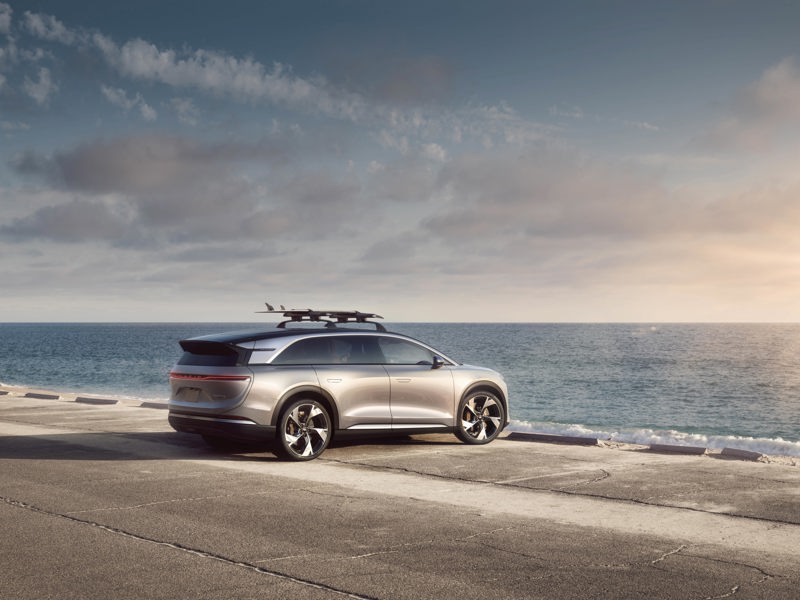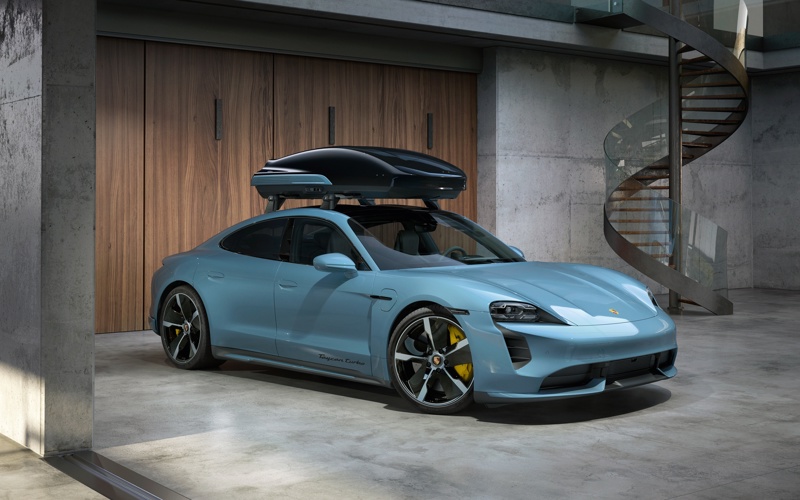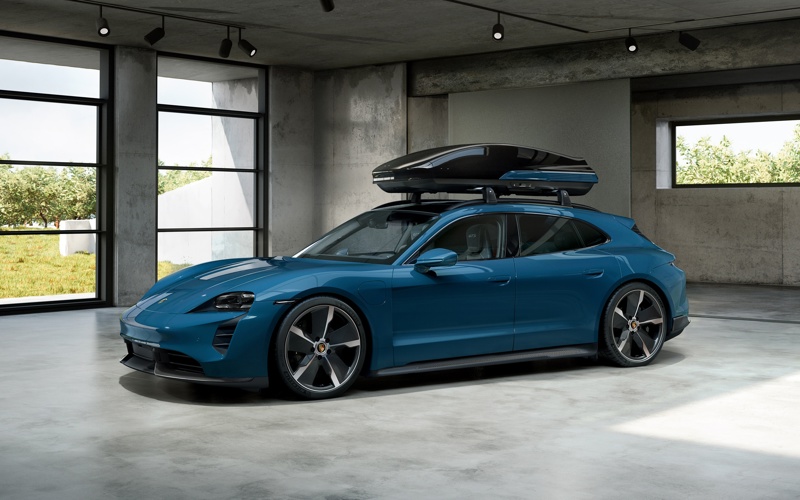- Cargo & Towing Capabilities
- Interior Cargo
- Frunk Cargo
- Roof Cargo
- Hitch Cargo
- Pickup Bed Cargo
- Towing
Roof Cargo
Roof cargo, such as racks or boxes, can increase the storage capacity of EVs, helping transport bulky, heavy, or irregularly shaped items like skis, bikes, kayaks, or tents.
Roof cargo can be a practical solution for increasing the storage capacity of electric vehicles (EVs). However, it comes with some drawbacks and limitations that EV owners should be aware of before installing it on their vehicles. This article explores factors affecting the performance and feasibility of roof cargo on EVs and provides tips and recommendations for choosing and using them.
Lucid Gravity with a surfboard on the roof rack
How Roof Cargo Affects EV Range
The main concern for EV owners using roof cargo is its impact on range, or how far they can drive on a single charge. Roof cargo can reduce the range of EVs by increasing the vehicle's weight and aerodynamic drag, leading to higher energy consumption.
The amount of range reduction depends on several factors, including the type, size, shape, and weight of the roof cargo, the vehicle's speed and driving conditions, and the EV's design and specifications.
Studies and experiments indicate that roof cargo can reduce the range of EVs by anywhere from 2% to 40%, depending on these variables.
Type of Roof Cargo
The type of roof cargo significantly affects range reduction. Generally, roof boxes are more aerodynamic than roof racks due to their smoother, more streamlined shape, which reduces air resistance. However, roof boxes also add more weight and height to the vehicle, increasing energy consumption and reducing stability.
Roof racks, on the other hand, are lighter and lower than roof boxes but expose the items to airflow, creating more drag and noise. The shape and size of the items on the roof rack also affect the vehicle's aerodynamics and range. For example, carrying a bike on a roof rack can reduce an EV's range by 10% to 15%, while carrying a kayak can reduce it by 20% to 40%.
Porsche Taycan with roof box
Speed and Driving Conditions
The vehicle's speed and driving conditions also influence range reduction. Generally, the faster the car goes, the more drag and energy consumption it experiences, leading to greater range loss. Driving on highways or in windy weather can exacerbate the effect of roof cargo on EV range.
Conversely, driving at lower speeds or in urban areas can mitigate the impact of roof cargo, as air resistance and energy consumption are lower. However, driving in stop-and-go traffic or on hilly roads can also increase energy consumption and range reduction, as the vehicle needs to accelerate and decelerate more frequently or overcome gravity.
EV Design and Specifications
The design and specifications of the EV also play a role in range reduction. EVs have different battery capacities, efficiencies, and aerodynamics, which affect how they cope with the extra weight and drag of roof cargo. For example, EVs with larger batteries or higher efficiencies can have more range to spare than those with smaller batteries or lower efficiencies.
EVs with better aerodynamics or lower weights can also experience higher range reduction than EVs with worse aerodynamics or higher weights.
Porsche Taycan with roof box
Tips for Using Roof Cargo on EVs
To minimize the impact of roof cargo on your EV's range and performance, consider the following tips:
- Choose Aerodynamic Cargo: Opt for roof boxes over roof racks when possible, as they are more aerodynamic and reduce drag.
- Minimize Weight: Keep the roof cargo as light as possible to reduce energy consumption.
- Secure Items Properly: Ensure that items on roof racks are securely fastened to minimize drag and noise.
- Drive at Moderate Speeds: Avoid high speeds to reduce aerodynamic drag and energy consumption.
- Plan Your Route: Consider driving conditions and plan routes that avoid highways or windy areas when possible.
By understanding the factors that affect roof cargo's impact on EV range and following these tips, you can make the most of your EV's storage capacity while minimizing range reduction.



